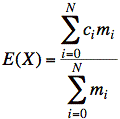|
|
By: Neil E. Cotter |
Probability |
|
|
|
Mean/expected value |
|
|
|
Mean = center of mass |
|
|
|
|
|
|
|
|
Ex: Prove the following:
a) E(X) = center of mass of the density function, f(x). That is, show
![]()
b) E(X) may be computed from centers of mass of pieces concentrated at single points. In other words, show that, for segments that cover x = (−∞,∞) without overlapping, we may reduce the "mass" of f(x) to single points:
![]() defines mass for ith segment of f(x)
defines mass for ith segment of f(x)
![]() defines center of mass for
ith segment of f(x)
defines center of mass for
ith segment of f(x)
 , or
, or  since total probability
(mass) = 1.
since total probability
(mass) = 1.
Pf: a) We break the integral into pieces and observe that E(X) is a constant that we may take outside the integral:
![]()
![]()
Since the total probability is equal to unity, the last integral has a value of unity and we obtain a value of zero, as desired:
![]()
b) Given
![]() , we have
, we have
![]() .
.
Thus,  . We
substitute this and the definition for mi
into the center of mass formula:
. We
substitute this and the definition for mi
into the center of mass formula:

The expression on the right is just the integral from −∞ to ∞ broken into N pieces that are then put back together by the summation. Thus, we have
 , and the proof is complete.
, and the proof is complete.